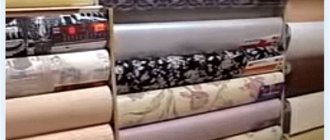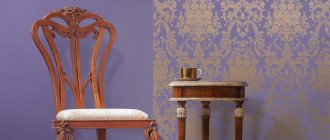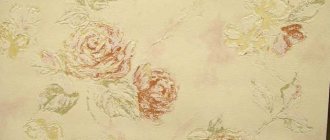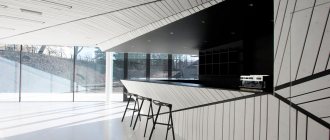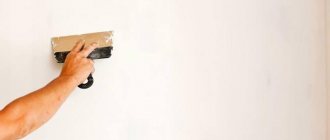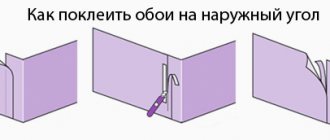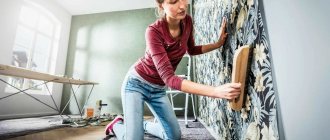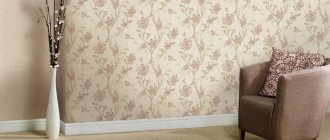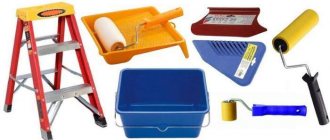How you want to update the interior for your room or your entire apartment! It lifts your spirits and improves your quality of life. Today, for wallpapering, you can turn to specialists. However, significant financial expenses will be required, but you can master the skills of wallpapering yourself and in a relatively short time.
Today in the consumer market you can see a wide range of different wallpapers. They come in both paper and non-woven, acrylic, velor, vinyl, silk-screen printing, and there are also options with small and large patterns. They are also divided by width: 50 cm, 70 cm, 100 cm, etc. This article will discuss the technology of pasting all types of wallpaper. We'll tell you how to glue rolls in the corners, with customization of the pattern and with different prints.
Where is the right place to start?
If the wallpaper is intended for overlapping wallpaper, you need to start from the corner near the window . This way the seams will not create shadows. And panels for end-to-end gluing can be started from any clearly visible place. It is most convenient to start from the corner by the window. This work is easier to do with two people.
- One person stands on a stepladder and marks a point with a pencil.
- A plumb line is applied to it, and the second person draws a line along the plumb line. At this mark they will begin to glue the wallpaper.
- Use a tape measure to measure the length of the wall.
- Roll out wallpaper on the floor and cut off the first strip, the size of which is 5-10 cm larger than the length of the wall.
With rapport selection
The most important point is the selection of the pattern.
Reference
All wallpapers have a constantly repeating pattern - rapport. We will combine it. It is best to do this on the floor.
Let's look at how to properly glue wallpaper with adjustments.
- The remaining roll is applied end-to-end to the first strip so that the pattern continues (how to glue wallpaper end-to-end?). The excess is cut off (read how to properly trim the canvas in difficult places and choose a design here).
- This strip is superimposed on the previous one.
- Then they do the same. You need to measure out as many strips as will fit on one flat wall up to the corner.
Start gluing:
- The wallpaper is coated with a thin, even layer of glue and allowed to soak a little (find out how to cook, use and store the paste yourself in this article).
- Then one person on a stepladder applies the strip to the wall, starting from the top previously marked point.
- The second person below applies the wallpaper, aligning it with the marked line.
- The piece is glued starting from the center, leveling out to the edges. This is done with soft rags or a roller.
- The second strip is applied end-to-end to the first. The pattern is combined without leaning it against the wall, since glued wallpaper is very difficult to move.
- When everything is in contact exactly, they begin gluing, just like with the first segment.
Corner sticker technology
The room has internal and external corners. The inner corners are glued like this:
- The strip, selected according to the pattern, is laid out in two halves.
- The first is glued to the corner with an overlap of 1.5-2 cm. The second - the remainder is applied exactly to the corner.
The technology for gluing external corners is no different from the previous ones:
- it is also necessary to divide the strip into two parts - up to the corner with an approach of several centimeters;
- and exactly on the corner.
We invite you to watch a video that explains the intricacies of wallpapering in the corners:
With different print
Recently, wallpaper with different patterns has become increasingly used in interiors. This is done in order to place accents on certain parts of the room that they want to highlight. For example, a fireplace or a large TV, etc. Also for separating zones: in the nursery - a sleeping area and a study area, in studio apartments - a living area and a kitchen area, and many other options (more about zoning space with wallpaper is described in another material) .
Attention
To paste wallpaper from different zones, mark on the walls with a pencil the places where they will be connected. Determine how many stripes of the first and second colors are needed and stick them on.
More complex is the horizontal combination of pasting:
- Measure the distance from the floor to the joint.
- Then, at this height, draw a line parallel to the floor with a pencil.
- First, glue the top part of the wallpaper without gluing the bottom edge. He, in turn, goes beyond the mark by a couple of centimeters.
- Then the lower panels are glued and the upper edge, which is also located slightly above the outlined line, is not glued.
- When everything is dry, use a sharp knife to follow the mark, resting on a metal spatula. Excess paper strips are removed, and the unglued edges are glued end-to-end (how to join wallpaper?).
- If it doesn’t turn out very smooth, then the joint can be decorated using molding, plinth or paper border (you can read about how to glue wallpaper seam to joint and decorate the seams if it turns out not straight, here).
We invite you to watch a video about the technology of combining wallpaper:
Options for wallpapering in the bedroom
Today, manufacturing companies offer a wide selection of wallpapers of various textures and colors, so it is very difficult to give preference to any one option. To decorate a bedroom, smooth or textured wallpaper is mainly used.
Paper wallpapers are especially popular. Their cost is an order of magnitude lower than other types of wallpaper, and the choice of colors is simply huge.
Before choosing wallpaper in a store, you should carefully study information about their types, properties, advantages and disadvantages, and view all possible finishing options. The process of wallpapering is quite labor-intensive and time-consuming. Therefore, it is better to prepare and decide in advance what style of interior you will adhere to.
Wallpapering a small bedroom
It is very important to choose the right wallpaper color for finishing the bedroom, because not only the interior of the room, but also the mood of the residents, as well as the health of their sleep will depend on this. The choice of wallpaper color for the bedroom is influenced by many factors, but mainly you should start from your own preferences.
When choosing a color for a bedroom, you must take into account its parameters and the degree of natural light in order to visually adjust the space.
Healthy sleep depends on the energy that certain colors carry. Wallpaper in a soft blue color will help you relax and unwind mentally. Decorating the bedroom in dark blue will make moments of relaxation pleasant and promote sound sleep.
What other color to choose:
- Green, which also promotes relaxation and will allow you to have a good rest after intense intellectual work.
- Metal, which will give a pleasant coolness to the room if its windows face the sunny side. Metallic wallpaper will cool the bedroom on a hot summer day.
- Brown and beige, which will help create comfort and coziness, will give a warm and calm atmosphere.
Wallpaper in light shades will help visually increase the space in a small room. In a bedroom with a small area, it is better to avoid black wallpaper and wallpaper with large patterns. When choosing wallpaper, you should also take care of combining it with lighting fixtures.
Wallpapering a bedroom with furniture of different styles
In order for the interior of the room to look advantageous, the wallpaper must have a suitable color and appropriate texture, and at the same time successfully harmonize with the furniture and other interior items. In most cases, wallpaper provides only a background for the interior decor.
Of course, wallpaper is of great importance in the design of a room, but it is not enough just to choose the right color and texture. It is important that they are neutral, without flashy colors, because the bedroom primarily acts as a place for relaxation and sleep. It is better to plan the choice of wallpaper last, when the final design style has already been determined and the appropriate furniture has been purchased.
Combination options:
- For dark-colored furniture, you should choose wallpaper in warm and light colors.
- For light-colored furniture, you need to choose wallpaper in light or muted shades.
At the discretion of the owners, you can either combine the colors of wallpaper and furniture, or play up their contrast. The second option will look good only in a large spacious room.
There are many design and construction portals on the Internet where you can get acquainted with all kinds of interior options and design projects. Using their example, you can clearly imagine the design of your future bedroom and build on this option when choosing materials for decoration.
Meter rolls
Recently, wallpaper manufacturers have increasingly begun to offer widened rolls of a meter width, or more precisely 106 cm. Their use reduces financial costs and reduces the number of seams, and this in turn leads to a visually seamless effect. It is also undeniable that fewer strips are easier to cut and then apply with glue. The gluing effort will take half as much due to the smaller number of sheets.
Along with all the advantages of wide wallpaper, there are also some disadvantages:
- You need to carefully level the wall before pasting, since unevenness will not allow you to make the joints invisible (how to level walls for wallpaper?).
- It is possible to increase the amount of material due to the fact that there may not be enough wallpaper to cover a small area of the room, and you will have to buy a whole roll.
- To make the work easier, you will need two stepladders to ensure better smoothing of the joints.
In general, the technology for selecting a pattern and covering a room with wide panels is the same as with standard narrow ones.
Read more about the features of covering a room with meter-long wallpaper here.
Non-woven
Advice
Non-woven wallpaper has a thick base. To paste them, careful leveling of the wall is not required, since roughness will not be noticeable. They have a good appearance, and therefore most often consumers choose them.
Non-woven walls are not afraid of detergents . Contamination is easily washed off. After pasting, they do not stretch, dry out or become deformed. Acrylic and dispersion dyes adhere perfectly to this type of wallpaper. This type adheres well to surfaces made of:
- paper;
- wood;
- drywall (how to prepare drywall for wallpapering?);
- chipboard;
- plasters;
- concrete and other similar materials.
You can achieve good results without resorting to the help of specialists. The main thing is to strictly follow the step-by-step instructions:
- Before pasting, clean the walls of old wallpaper, remove defects and dirt.
- If the wallpaper is to be glued to a previously painted surface, then it will be rubbed down with sandpaper to make it rougher.
- Treat the walls with a primer and wait for it to dry, according to the instructions.
- Begin pasting from the corner of the room. Draw a precise line from the ceiling to the floor using a plumb line or level.
- Then they cut all the strips at once for the even walls of the room, after making sure that the height is the same in all places. Cutting is carried out by selecting a pattern (read how to properly cut wallpaper and select a pattern here). This is convenient to do on the floor.
- Dilute the glue and let it sit as indicated in the instructions. By the way, the latter should be mandatory for non-woven wallpaper.
- Carefully read the instructions for gluing exactly your type of material. Sometimes it is enough to coat only the walls with glue, and sometimes even the workpieces themselves.
- It is important to glue the first sheet strictly vertically. It is the starting point for all subsequent panels.
- It is better to smooth the wallpaper with a roller.
We invite you to watch a video about sticking non-woven wallpaper with a pattern:
We described in more detail how to glue non-woven wallpaper separately.
Options for wallpapering in the living room: tips and nuances
The design of this room deserves special attention, since it is often visited not only by household members, but also by guests. Therefore, they always try to create a unique interior in the hall that will give maximum comfort. As already noted, there are various options for wallpapering in the living room. Of these, it is necessary to choose exactly the one that will best meet the desires and interests of all family members.
The design of the hall, like any other room, has its own characteristics. In order for the future interior to meet all expectations, you must adhere to the following rules:
- You can visually increase the height of the ceiling using wallpaper with vertical stripes, and wallpaper with horizontally oriented patterns will help expand the space;
- for small living rooms you should not choose canvases with large patterns;
- a dark room with insufficient lighting requires wallpaper in light colors;
- When combining several types of wallpaper in a room, you need to take into account the direction of their style.
How to do this economically?
Most often, wallpaper with a pattern is chosen for the interior. This significantly improves the appearance. But, of course, it increases the consumption of materials due to the selection of patterns. If the pattern is small and often repeated, then this overrun is not large. It happens that rapport reaches 60 cm, which leads to an increase in the amount of material. There is one method by which you can minimize sections of wallpaper that are not used in the future:
- Unfold two, or preferably three, coils.
- Visually identify a repeating pattern.
- From one roll, 40 cm of canvas is cut off from the top, and from the other from the bottom, that is, the roll is unwound to the end.
Why is that? This is due to production technology. The machine cuts the wallpaper with a margin of approximately half a meter, which is necessary for further selection of the design. This is what you need to take advantage of. Now they select a design from not just one roll, but from three. In the third roll, the design will fit without cutting off 40 cm from it.
Thus, waste is reduced from one meter to 20 cm.
Read about how to correctly calculate the required amount of wallpaper here.
Using scraps
The scraps that remain after adjusting the pattern can be safely used in inconspicuous places. This could be the surface of the wall above the window, door, or in the radiator area. When using this method, it is quite possible to save a whole roll of wallpaper.
General recommendations
The following recommendations exist:
- Before pasting, check the article and lot number in all reels. This is necessary as the shade may vary slightly from batch to batch.
- The old wallpaper is removed, the unevenness and holes are sealed using putty (how to fill unevenness on the wall is written here, and how to putty the walls under wallpaper, find out here).
- The surface is coated with a primer, following the technology indicated on the packaging.
- The strips are measured 5-10 cm longer than the required size, and then the excess is cut off.
- The glue must be exactly suitable for the type of material that will be used.
- After diluting the glue, there should be no lumps in it under any circumstances.
- It should be applied using a roller; in those places where the tool does not reach, you need to use a paint brush.
- Wallpaper is applied from top to bottom.
- Before starting work, check that all windows are closed. Wallpaper does not like drafts. Only after complete drying can the room be ventilated.
- Excess glue must be removed immediately with a well-absorbing cloth.
- If everything has dried well, and bubbles have formed in some places, then they are cut with a knife, coated with glue and glued to the wall with an overlap.
- It happens that the edges of wallpaper come off after drying (why does wallpaper peel off and what to do?). The glue is applied with a brush or injected using a syringe without a needle. Everything is smoothed over again with a soft cloth.
- If a gap has formed between the strips, such edges are carefully folded back, a strip of wallpaper remnants is glued in place of the gap, and then the folded edges are applied to the strip.
You can master the skill of wallpapering yourself. The main thing is not to be lazy and think through everything in advance: how you want your interior to look, how much wallpaper you need, what auxiliary materials are needed. Then you need to re-read this article several times so as not to forget anything.
Designer tips for wallpapering the living room.
Options for gluing two types of wallpaper in the hall will help to identify functional areas. Areas are highlighted using canvases of different textures and colors or companion wallpaper.
You can make the main design with plain embossed wallpaper, and cover one wall with canvases with bright patterns or stripes.
Another original interior option involves highlighting strips of plaster or polyurethane on one of the walls. At the same time, individual areas are covered with contrasting wallpaper, due to which the living room looks quite stylish.
